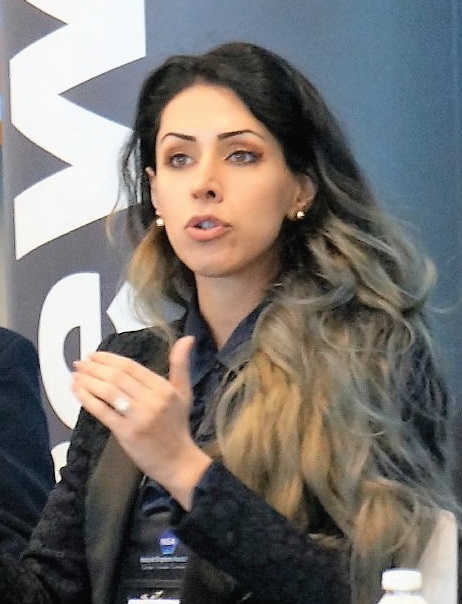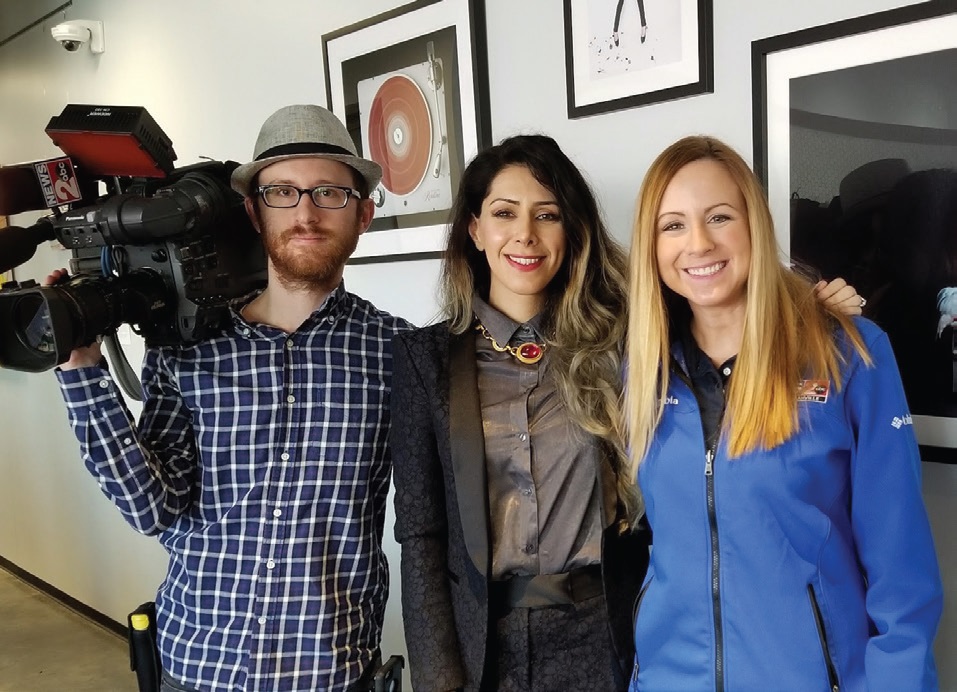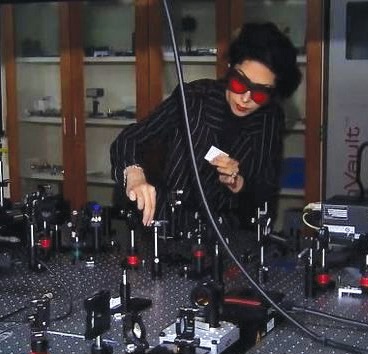TLT: Please explain the role of the National Graphene Association and its heritage.
Jarrahi-Cinker: The National Graphene Association (NGA) is the main organization and body in the U.S. promoting and advocating for commercialization of graphene and addressing critical issues such as standards and policy development. Prior to NGA there was no organized momentum in the U.S. when it came to graphene commercialization, which set the U.S. back considerably compared to other regions in the world such as Europe and China.
NGA was launched two years ago to remedy this situation and create U.S. competitiveness. In such a short time we’ve had great success in changing the landscape for the graphene industry. We now have more than 1,400 members and 17 corporate partners and close-knit collaborations with major entities and graphene-focused organizations globally.
On the advocacy side, we have implemented NGA policy objectives in two major pieces of legislation, and we are strongly involved in the development of ISO standards for graphene and working on graphene environment, health and safety (EHS) and regulatory landscape. We will be hosting the American Graphene Summit, a high-level international gathering of graphene leaders and future stakeholders, in Washington D.C., May 21-22. The meeting is keynoted by Sen. Roger Wicker and, in partnership with the UK government, brings together leaders of U.S. industry, government agencies and key international figures in graphene to engage in a dialogue on shaping the global architecture surrounding graphene technologies and its impact on the U.S. and global economy.
TLT: Why did you decide to get involved with graphene? Does this stem from your education at Vanderbilt University?
Jarrahi-Cinker: If I look back, it wasn’t really a choice. I initially went to Vanderbilt to be part of the stellar MRI program at the Institute of Imaging Science. Then I took one look at graphene, and it was so fascinating that I had no choice but to change direction.
Graphene, the first 2D material discovered, thinnest, strongest, highest electron mobility ever tested—it was more like sci-fi. That initial excitement persisted and still persists.
From the perspective of a physicist, graphene is truly a wonder material. I’ve also always had an entrepreneurial spirit, and from very early on knew I wanted to continue the graphene journey in a more commercially focused capacity. That desire to eventually have a graphene startup prompted me to stick with graphene throughout my doctorate and postdoc.
It was certainly a different experience once I stepped out of academia and started my own company! I was faced with the reality and challenges of commercializing a novel nanomaterial. Consulting for end-user industries that wanted to use graphene gave me yet another perspective on the challenges of graphene commercialization, which was different than that of a researcher or a material startup owner. The multi-faceted experience is what got me the bird’s eye view of the landscape and has enabled me to devise solutions with multiple stakeholders in mind and grow NGA’s global reach to what it is today.
TLT: Describe your responsibilities as executive director. What is your typical work day?
Jarrahi-Cinker: Lots and lots of emails and conference calls and about an hour or two a day of sitting down, thinking and planning while talking to myself. I bet it looks odd from the outside, but people around me have gotten used to me mumbling and drawing things in the air!
As executive director, one of my main jobs is to put together frameworks and systems so that stakeholder entities—graphene companies, academic institutions, end-user industries, government agencies, regulatory and standard bodies—can work more effectively together and all contribute to the end goal, which is the commercial prosperity of graphene. It is like connecting the dots, and when dots are missing, creating them and putting them into the proper place. It is as intangible as it gets!
The interaction in each case is different, the collaborative platform in each case is different and, in most cases, even the problems are undefined. For example, one of the areas we are working on at the moment is graphene international standards. Here is the challenge: U.S. participation is lacking. So as the NGA, how do we address the problem? We need to get U.S. graphene companies involved since their perspective is the most relevant. But what is the reason behind their lack of participation? Is it a matter of education, lack of time, lack of resources or clunkiness of the process? Which national and international organizations can we work with for the education component? As the NGA, how can we streamline the process so they can receive and comment on the ongoing standard documents?
The one part of my job that is a lot more tangible (and just as enjoyable) is organizing our graphene conferences and summits, which are some of the most commercially focused graphene conferences in the world. It energizes me to see all the stakeholders under one roof, discussing opportunities and forming partnerships and collaborations.
 Dr. Zina Jarrahi-Cinker speaking at the National Graphene Association’s annual meeting, the Graphene Innovation Summit 2017.
TLT: What ways are you seeing graphene incorporated into lubricants?
Jarrahi-Cinker:
Dr. Zina Jarrahi-Cinker speaking at the National Graphene Association’s annual meeting, the Graphene Innovation Summit 2017.
TLT: What ways are you seeing graphene incorporated into lubricants?
Jarrahi-Cinker: There exists a great body of work on graphene solid and oil-based lubricants. As a solid lubricant, graphene is shown to effectively work in both dry and humid environments. Some studies show a five- to six-times decrease in friction coefficients and 10,000-times decrease in wear. We have institutions such as Argonne National Laboratory that work closely with companies evaluating graphene in the lubricant segment and help bridge the gap between lab and industry. On a relevant note, the price of graphene flakes/powders (which is the form of graphene that would be used in graphene lubricants) have dropped significantly in the last five to seven years, which makes mass scale integration a much closer reality.
TLT: What is the most interesting tribology use of graphene (lubricant or friction related)?
Jarrahi-Cinker: The work done on graphene-enabled
superlubricity is very interesting, especially the recent work of Dr. Anirudha Sumant of Argonne National Laboratory with graphene-wrapped nanodiamonds forming nanoscrolls and reducing contact as they slide against the surface.
TLT: Are there any particular challenges related to graphene nanoparticle development in the lubricants, environmental or regulatory industries?
Jarrahi-Cinker: Graphene is a novel material and is wrestling with challenges of a nascent but blooming industry. Some of the challenges we are actively addressing at the NGA are development of internationally accepted standards, bridging the gap between academia and industry, establishment of reliable graphene-testing programs, connecting current and future stakeholders and providing frameworks to facilitate the evaluation and integration of graphene in new industries.
Safety demonstrations and regulatory acceptance is another area on which we have focused on more recently at the NGA. We are working with various national and international organizations to create a roadmap for the graphene EHS landscape and address some of the study and regulatory requirement gaps. Tackling these challenges head on will, in turn, expedite industry acceptance and adoption.
 Zina Jarrahi-Cinker with Danielle Breezy and the ABC News 2 crew for the Women 2 Watch segment.
TLT: What OEMs are working hand in hand with the NGA to develop this technology?
Jarrahi-Cinker:
Zina Jarrahi-Cinker with Danielle Breezy and the ABC News 2 crew for the Women 2 Watch segment.
TLT: What OEMs are working hand in hand with the NGA to develop this technology?
Jarrahi-Cinker: The thinnest, strongest material ever existed, flexible, transparent, electrically and thermally conductive, graphene has so many unique properties in one package that makes it suitable for use in a myriad of industries. Each industry will be looking at graphene to solve a specific problem.
For example, the automotive industry would look at graphene for improved sensors, lighter and more impact-resistance body, longer lasting tires, heated car seats with enhanced thermal regulation and better performing engine oils. The electronics sector would be looking to graphene for device miniaturization, replacing metallic interconnects with graphene interconnects, improve heat sinks and device thermal management. The aerospace industry would look to graphene for reducing the water retention of composite planes, lightning strike resistance, stealth capabilities and enhanced infrared sensors. Graphene can be tailored to address a wide range of challenges.
TLT: What markets are developing this nanotechnology the fastest?
Jarrahi-Cinker: When it comes to graphene, the commercial development will happen in two waves.
The first phase is where graphene will be used to enhance already existing products (e.g., as additive to concrete, sporting goods, composites, making them lighter, stronger, enhancing thermal regulation). This is the phase we are in right now, and we are already seeing many products entering the market.
The second wave of products will be in the higher tech and more R&D-intensive segments such as electronics, next-generation biosensors and detectors where graphene is uniquely suited for a specific purpose, and it plays a role that can’t be played by any other material. For example, due to its linear energy band structure, graphene has universal absorption over a wide range of wavelengths, and that makes it quite unique for use in photosensors. In this case, we have a great deal of successful R&D done, but a mass-produced product is still a few years away.
 Conducting experiments on graphene at Vanderbilt University’s ultrafast spectroscopy lab. (Source: WKRN.)
TLT: What is the most interesting non-tribology related use?
Jarrahi-Cinker:
Conducting experiments on graphene at Vanderbilt University’s ultrafast spectroscopy lab. (Source: WKRN.)
TLT: What is the most interesting non-tribology related use?
Jarrahi-Cinker: We are carbon beings. Think of graphene as a form of carbon with very high electrical conductivity, so the interface of graphene and biology and the potential in human body is quite fascinating to me.
For example, in my previous company we were working on graphene electrodes for brain stimulation. In this case, graphene was replacing the metal electrodes currently used for treating Parkinson’s disease. The problem is the current electrodes are not MRI compatible (metallic); they can corrode, fail and cause scar tissue. Graphene is biocompatible, a metal-free electrical conductor, does not corrode and has much higher current-carrying capacity compared to most metals. It is easy to see why graphene-based electrodes for neural stimulation would most likely be the next innovative step taken in this field, and that is just one example.
You can reach Dr. Zina Jarrahi-Cinker at zinajc@nationalgrapheneassociation.com.